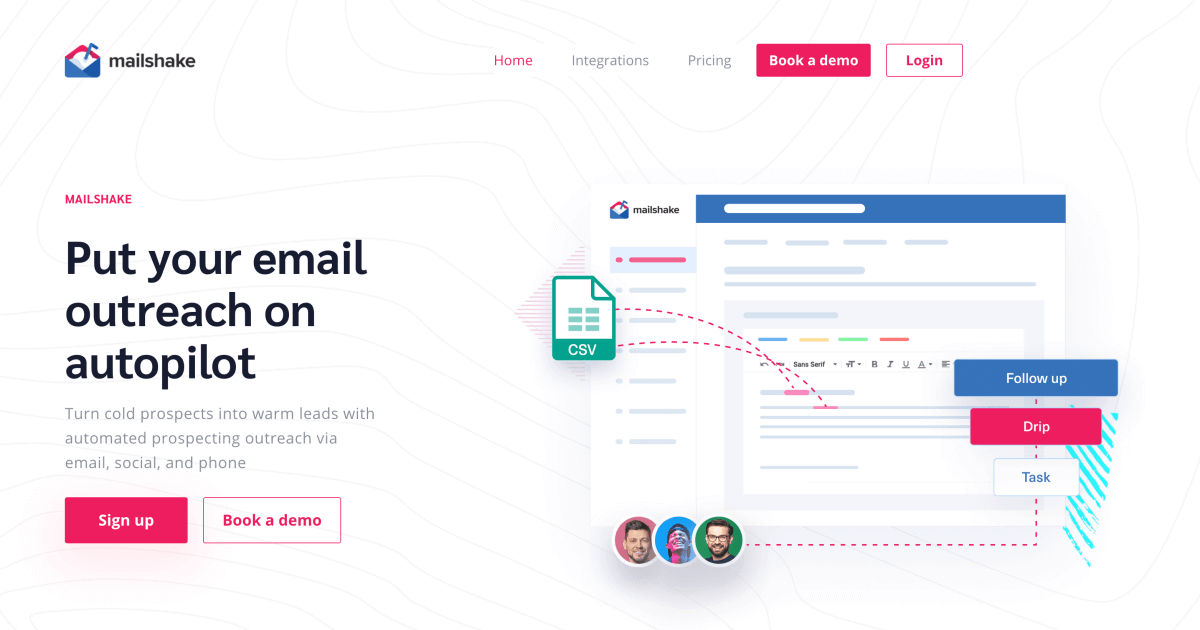Exploring the Best Cold Email Software Solutions for Your Business.
Cold email software automates the process of sending emails to potential leads. It helps businesses streamline outreach efforts.
Cold email software is vital for businesses aiming to expand their reach. This tool simplifies the task of contacting potential clients by automating email-sending processes. It saves time, increases efficiency, and ensures that personalized emails are sent to the right audience.
With features like tracking, analytics, and follow-up scheduling, companies can optimize their outreach strategies. This software is especially beneficial for sales teams and marketers who need to manage large lists of contacts. By using cold email software, businesses can enhance their lead-generation efforts and improve their chances of converting prospects into customers.
Introduction To Cold Email Software
Cold email software helps businesses send emails to potential clients. It automates the process, saving time and effort. These tools are essential for effective email marketing campaigns.
Purpose And Benefits
The main purpose of cold email software is to enhance outreach. It helps businesses grow their client base. The software offers several benefits:
- Automation: Sends emails automatically, reducing manual work.
- Personalization: Customizes each email to make it relevant.
- Tracking: Monitors open rates and responses.
- Efficiency: Saves time and increases productivity.
These benefits make cold email software a valuable tool for businesses.
Common Use Cases
Cold email software is used in various scenarios:
| Use Case | Description |
|---|---|
| Lead Generation | Identifies and contacts potential clients. |
| Sales Outreach | Reaches out to prospects to boost sales. |
| Networking | Connects with professionals in the industry. |
| Content Promotion | Shares content with a larger audience. |
These use cases show the versatility of cold email software.
Key Features
Cold email software is a powerful tool for businesses. It helps in reaching out to potential clients and partners. Understanding the key features of cold email software can help you make the most of it. Let’s delve into the core functionalities that make cold email software indispensable.
Automation Capabilities
Automation capabilities are a standout feature of cold email software. These tools allow users to automate repetitive tasks. You can schedule emails to be sent at specific times. This ensures that your emails reach recipients when they are most likely to read them. Automation also helps in sending follow-up emails without manual intervention.
| Feature | Description |
|---|---|
| Email Scheduling | Send emails at pre-set times |
| Follow-up Automation | Automatically send follow-up emails |
| Task Management | Manage tasks with ease |
Personalization Options
Personalization options are crucial for effective cold emailing. Cold email software allows you to personalize each email. This makes your emails feel more human. You can customize subject lines, greetings, and body text. Personalized emails have higher open and response rates.
- Custom Subject Lines
- Tailored Greetings
- Individualized Body Text
Using placeholders, you can insert recipient names and other details. This makes your email more engaging and relevant. Personalized emails build trust and rapport with your audience.
Choosing The Right Software
Choosing the right cold email software can be challenging. Different software offers various features and benefits. It’s crucial to find one that fits your needs. This section will help you make an informed decision.
Factors To Consider
- Ease of Use: The software should be user-friendly. You should be able to navigate it easily.
- Automation Features: Look for automation capabilities. It should handle tasks like follow-ups.
- Integration: The software should integrate with your existing tools. This includes CRM systems and email providers.
- Deliverability: Ensure high deliverability rates. Your emails should reach the inbox, not the spam folder.
- Analytics: The software should offer detailed analytics. Track open rates, click rates, and replies.
- Pricing: Consider your budget. Find a solution that offers good value for money.
Popular Solutions
| Software | Key Features | Pricing |
|---|---|---|
| Mailshake | Automation, Analytics, Integrations | Starts at $59/month |
| Reply.io | Multi-channel Outreach, AI Assistance | Starts at $70/month |
| Woodpecker | Personalization, Campaign Management | Starts at $40/month |
| GMass | Gmail Integration, Mass Emailing | Starts at $12.95/month |

Credit: hunter.io
Setup And Integration
Setting up and integrating cold email software is key to success. The proper configuration ensures smooth operation and better results.
Initial Configuration
Initial configuration is the first step in using cold email software. Follow these steps to get started:
- Sign up for the software.
- Verify your email address.
- Set up your email account within the software.
- Import or add your contact list.
Ensure to double-check your settings. This avoids common mistakes.
CRM Integration
CRM integration is crucial for maintaining organized contacts. Follow these steps to integrate your CRM:
- Log in to your CRM account.
- Locate the integration settings.
- Connect your CRM with the cold email software.
- Sync your contact lists and segments.
Many cold email tools offer seamless CRM integration options. Popular CRMs include:
| CRM | Integration Steps |
|---|---|
| Salesforce | Follow in-app instructions to connect. |
| HubSpot | Use the API key for integration. |
| Zoho CRM | Enable the integration in settings. |
A well-integrated CRM helps streamline your outreach efforts. It ensures no lead is left behind.
Creating Effective Campaigns
Creating effective cold email campaigns is essential for business success. Cold email software helps streamline this process. The right approach increases engagement and conversion rates.
Crafting Compelling Messages
Crafting compelling messages is crucial. Your email must grab attention quickly. Use a catchy subject line. Keep the message clear and concise.
- Personalize your email with the recipient’s name.
- Highlight the benefits of your product or service.
- Include a clear call to action.
- Use simple language.
Always test different messages. See which ones perform best. Adjust accordingly for better results.
Segmentation Strategies
Segmentation strategies help target the right audience. Divide your email list into smaller groups. This allows for more personalized messages.
| Segment | Criteria |
|---|---|
| Demographics | Age, gender, location |
| Behavior | Past purchases, website activity |
| Interests | Hobbies, preferences |
Send tailored emails to each segment. This increases relevance and engagement. Use cold email software to automate this process.
Tracking And Analytics
Tracking and analytics are crucial components of cold email software. They help you understand how recipients interact with your emails. This data helps you improve your email campaigns. Let’s dive into two key aspects: monitoring engagement and interpreting data.
Monitoring Engagement
Engagement metrics tell you how recipients respond to your emails. Here are some common metrics:
- Open Rate: The percentage of emails opened by recipients.
- Click-Through Rate (CTR): The percentage of recipients who clicked on links within your email.
- Response Rate: The percentage of recipients who replied to your email.
- Bounce Rate: The percentage of emails that failed to deliver.
Tracking these metrics helps you understand what works and what doesn’t. You can adjust your email content based on these insights.
Interpreting Data
Data interpretation is as important as data collection. You need to know how to read the numbers. Here are some tips:
- High open rates indicate strong subject lines.
- Low CTRs suggest your email content needs improvement.
- High bounce rates could mean your email list is outdated.
- Low response rates may indicate a lack of interest.
Use this information to refine your email campaigns. Always aim to improve your metrics. Better metrics lead to more successful campaigns.
Best Practices
Cold email software can be a powerful tool for reaching new customers. However, to maximize its effectiveness, it’s crucial to follow best practices. This ensures your emails are not only delivered but also read and acted upon.
Avoiding Spam Filters
To avoid spam filters, use a professional email address. Avoid using too many images or links. These are often flagged as spam. Write concise subject lines that don’t look like spam.
- Use a professional email address
- Limit images and links
- Write concise subject lines
Personalize your emails. Mention the recipient’s name and company. This reduces the chance of your email being marked as spam.
Maintaining Compliance
It’s important to stay compliant with email marketing laws. Always include an option to unsubscribe. This is required by laws like CAN-SPAM.
- Include an unsubscribe link
- Provide your physical mailing address
Make sure you have permission to email your contacts. Sending unsolicited emails can get you blacklisted. This will hurt your reputation and deliverability.
| Best Practices | Details |
|---|---|
| Avoid Spam Filters | Use professional email, limit images/links, personalize content |
| Maintain Compliance | Include unsubscribe link, provide mailing address, get permission |

Credit: mailshake.com
Case Studies
Cold email software has transformed how businesses reach potential clients. Real-world examples show the power of these tools. Let’s explore some case studies.
Successful Campaigns
Several companies have seen remarkable success with cold email software.
| Company | Industry | Results |
|---|---|---|
| Tech Innovators | Technology | 20% increase in leads |
| Health Solutions | Healthcare | 15% boost in appointments |
| Global Finance | Finance | 25% rise in client meetings |
These examples highlight the effectiveness of cold email software. Businesses can see significant growth and engagement.
Lessons Learned
Successful campaigns provide valuable insights.
- Personalization is key. Tailor each email to the recipient.
- Use a clear call to action. Guide the recipient on the next steps.
- Ensure consistent follow-ups. Don’t rely on a single email.
- Track open rates and responses. Adjust strategies based on data.
These lessons help refine cold email strategies. Implementing them can lead to better results.

Credit: breadcrumbs.io
Frequently Asked Questions
What Is Cold Email And How Does It Work?
A cold email is an unsolicited message sent to potential customers or clients. It aims to establish a connection or promote services. Cold emails work by capturing attention, providing value, and prompting a response or action. Effective cold emails are personalized, concise, and relevant to the recipient.
Is Cold Emailing Illegal?
Cold emailing is not illegal if it follows regulations. Ensure compliance with laws like the CAN-SPAM Act and GDPR.
Why Use Cold Email Software?
Cold email software automates outreach, saving time and increasing efficiency. It helps personalize emails, boosting response rates. The software tracks email performance, providing valuable insights. It ensures compliance with email regulations, reducing legal risks.
What Is The Difference Between Email And Cold Email?
Email is sent to known contacts, while cold email targets new, unfamiliar recipients. Cold emails aim to initiate contact.
What Is Cold Email Software?
Cold email software automates sending personalized emails to potential clients, boosting outreach efficiency and conversion rates.
How Does Cold Email Software Work?
Cold email software schedules, personalizes, and tracks email campaigns, making outreach more efficient and effective.
Conclusion
Cold email software streamlines outreach, saves time and boosts efficiency. It automates tasks, ensuring personalized communication. This tool is essential for businesses aiming to expand their network. By leveraging cold email software, you can enhance your marketing strategy and achieve better results.
Embrace this technology to stay competitive and drive growth.








